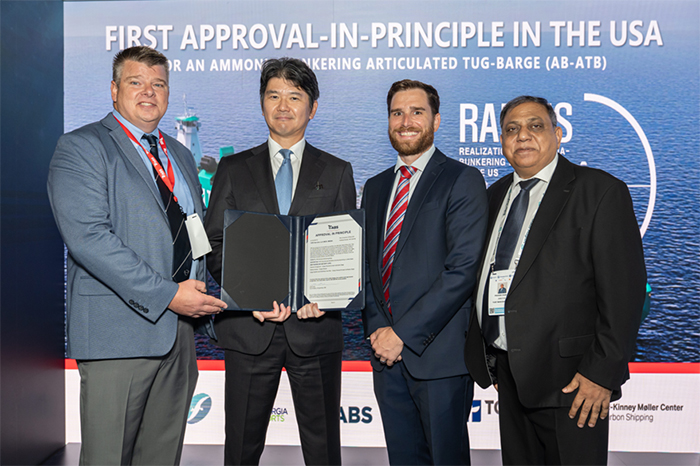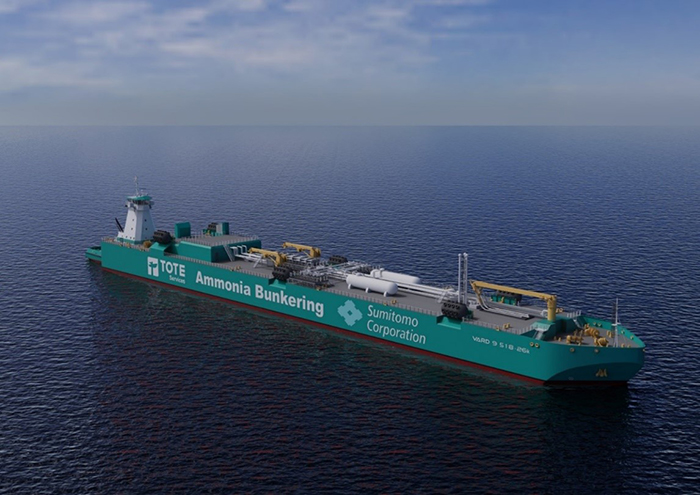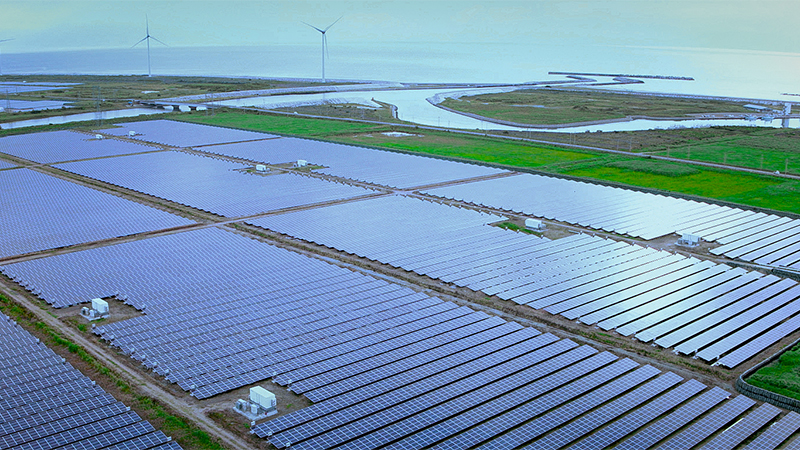Sep. 19, 2024
American Bureau of Shipping
Fleet Management Limited
Sumitomo Corporation
TOTE Services
Us First Approval in Principle for Ammonia Bunkering Vessel- Targeting Commercial Operations by 2030 to Decarbonize the Maritime Industry -
American Bureau of Shipping (ABS), Fleet Management Limited, Sumitomo Corporation and TOTE Services (collectively the “Parties”) announced today the United States’ First Approval in Principle ("AiP") for the initial design of ammonia bunkering articulated tug-barge (*1) /AB-ATB) from ABS. The award ceremony was held in Houston at Gastech 2024, the world's largest energy conference. The approval was achieved in cooperation with the RADIUS consortium, consisting of ABS, A.P. Moller – Maersk A/S, Fleet Management Limited, Georgia Ports Authority, Maersk Mc-Kinney Moller Center for Zero Carbon Shipping (MMMCZCS), Sumitomo Corporation, and TOTE Services (collectively the “Consortium”). The barge design and engineering were completed by VARD Marine US, Inc. (VARD). This design approval is an important step on the maritime industry’s decarbonisation journey where ammonia-fuelled vessels are seen as one of multiple fuel pathways.
About this project
The Consortium, established in March 2023, has been conducting a feasibility study on ship-to-ship bunkering of reduced emission ammonia along the U.S. East Coast. This includes the development of a cost-effective supply chain for the procurement, transportation, and storage of reduced emission ammonia fuel, as well as the design of AB-ATB and related supply chain infrastructure.
The AB-ATB was designed to be compatible with vehicle carriers including Aurora Class PCTC (*2) recently delivered to Höegh Autoliners, the Norwegian shipping company, for bunkering operation at the ports of Jacksonville, Florida, and Brunswick, Georgia as well as a 15000 TEU (*3) ammonia-fuelled container vessel whose concept design was created by MMMCZCS, for bunkering operation at the port of Savannah, Georgia.
The Parties expect this design approval to motivate and encourage the maritime industry to develop and order such types of ammonia fuelled vessel. This approval is a significant milestone in accelerating the potential of the first US ammonia bunkering vessel, targeting commercial operations by 2030.
Ammonia as marine fuel
Ammonia has long been considered one of the most promising alternative marine fuels to reduce greenhouse gas (GHG) direct emissions within the shipping industry. This aligns with the revised International Maritime Organization (IMO)’s strategy to reduce GHG emissions from international shipping by at least 20% by 2030 compared to 2008 levels, and to reach net-zero emissions on a life-cycle basis by 2050.
In the U.S. market, which has the potential to become the world’s largest producer of clean ammonia, the Parties will aim to contribute significantly to achieving the IMO’s goals by introduction of the AB-ATB that connect supply and demand. According to Bloomberg NEF projections, the U.S. is expected to account for 41% of the global supply of reduced emission ammonia by 2030.
Aiming for new ammonia bunkering guidance and outline of the future step
The world's first use of ammonia as marine fuel was successfully conducted at port of Singapore, the world's largest bunkering hub, in 2024, with prudent preparations including safety workshops, trainings, drills and plume model (*4) development. Formulation of new safety and operational standards is a significant undertaking requiring the coordinated efforts of many stakeholders. The RADIUS Consortium is referencing the ‘industry-first’ ammonia bunkering guidance released by ABS in July 2024, and will proceed further with detailed risk assessments with various stakeholders and relevant government agencies in the U.S. as part of the next steps towards commencing ammonia bunkering operation along the U.S. East Coast.
“This is an exciting milestone for our feasibility study and project teammates. Having an approved basic design for the AB-ATB is another step toward maturity for ammonia as a marine fuel. ABS is committed to supporting the maritime industry as it pursues low-carbon, more sustainable operations. We have extensive insight into the development and application of ammonia as a marine fuel, and we are proud to share our learnings with this team,” said Panos Koutsourakis, ABS Vice President, Global Sustainability, as a representative of the consortium.
(*1) AT-ATB is a vessel that consists of a tug and a barge that are joined together to form a single unit, and is intended for providing ammonia to a vessel as a fuel.
(*2) PCTC is a Pure Car and Truck Carrier
(*3) TEU is a Twenty-foot equivalent unit, a unit that expresses the container ship's carrying capacity with a 20-foot container as one unit.
(*4) Simulation model of the diffusion of smoke and other substances in windy conditions


| Partners | Key Roles |
|---|---|
| American Bureau of Shipping | ABS will conduct operational risk assessment of ammonia StS bunkering and lead in the coordination with relevant authorities in the US to establish port regulations and operational guidelines. |
| A.P. Moller – Maersk A/S | Maersk will provide input specific to container vessels and will work on development of safe and reliable ammonia bunkering procedures from operator's point of view. |
| Fleet Management Limited | Fleet Management Limited will work on the development of safe and reliable ammonia bunkering procedures from a ship manager point of view, and provide technical support in the design development of Ammonia-Fueled Vessels and AB-ATB. |
| Georgia Ports Authority | GPA will facilitate coordination with relevant authorities in the US to foster port regulations and operational guidelines, leveraging experiences that support the launch of LNG Bunkering at port of Savannah. |
| Maersk Mc-Kinney Moller Center for Zero Carbon Shipping | The Center will conduct Well-to-Wake Life Cycle Analysis (LCA) of ammonia and support the establishment of standards for the safe use of ammonia as marine fuel. |
| Sumitomo Corporation | Sumitomo will structure, integrate and promote the end-to-end supply chain of green/blue ammonia, which includes sourcing, transportation, storage and bunkering. |
| TOTE Services | TOTE will develop AB-ATB and safe and reliable ammonia bunkering procedures from AB-ATB's point of view, leveraging on competencies and experiences in relation to safe and reliable operation track record of LNG Bunkering in the US. |
Related Information : MARITIME INDUSTRY LEADERS TO EXPLORE AMMONIA AS MARINE FUEL IN THE US EAST COAST



